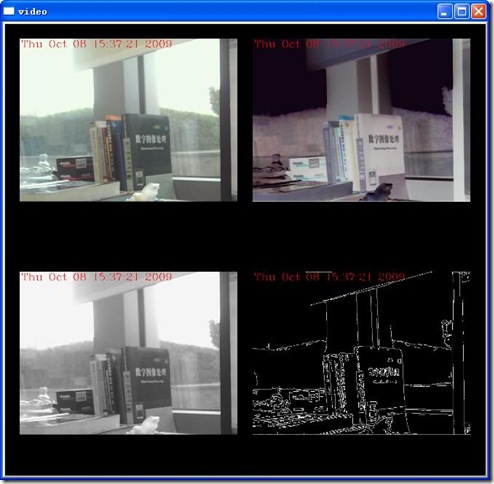http://blog.csdn.net/chenyusiyuan/article/details/4642297
參考OpenCV中文論壇的一個帖子(http://www.opencv.org.cn/forum/viewtopic.php?f=1&t=7996&start=0)實現了在一個窗口顯示多個視頻子窗口,能夠讀入單個的視頻或攝像頭數據,然後在一個窗口中分別顯示原始幀圖像、反色圖像、灰度圖像以及Canny邊緣檢測圖像。並在每個子窗口左上角顯示系統時間,函數cvShowManyImages是改寫的。
代碼如下:
#include "stdafx.h" #include <cv.h> #include <cxcore.h> #include <highgui.h> #include <stdio.h> #include <stdarg.h> #include <time.h> // 隱藏 console 窗口 #pragma comment( linker, "/subsystem:/"windows/" /entry:/"mainCRTStartup/"" ) // 單窗口顯示多幅圖像的函數 void cvShowMultiImages(char* title, int nArgs, ...) { // img - Used for getting the arguments IplImage* img; // DispImage - the image in which all the input images are to be copied IplImage* DispImage; int size; // size - the size of the images in the window int ind; // ind - the index of the image shown in the window int x, y; // x,y - the coordinate of top left coner of input images int w, h; // w,h - the width and height of the image // r - Maximum number of images in a column // c - Maximum number of images in a row int r, c; // scale - How much we have to resize the image float scale; // max - Max value of the width and height of the image int max; // space - the spacing between images int space; // If the number of arguments is lesser than 0 or greater than 12 // return without displaying if(nArgs <= 0) { printf("Number of arguments too small..../n"); return; } else if(nArgs > 12) { printf("Number of arguments too large..../n"); return; } // Determine the size of the image, // and the number of rows/cols // from number of arguments else if (nArgs == 1) { r = c = 1; size = 300; } else if (nArgs == 2) { r = 2; c = 1; size = 300; } else if (nArgs == 3 || nArgs == 4) { r = 2; c = 2; size = 300; } else if (nArgs == 5 || nArgs == 6) { r = 3; c = 2; size = 200; } else if (nArgs == 7 || nArgs == 8) { r = 4; c = 2; size = 200; } else { r = 4; c = 3; size = 150; } // Create a new 3 channel image to show all the input images DispImage = cvCreateImage( cvSize(60 + size*r, 20 + size*c), IPL_DEPTH_8U, 3 ); // Used to get the arguments passed va_list args; va_start(args, nArgs); // Loop for nArgs number of arguments space = 20; for (ind = 0, x = space, y = space; ind < nArgs; ind++, x += (space + size)) { // Get the Pointer to the IplImage img = va_arg(args, IplImage*); // Check whether it is NULL or not // If it is NULL, release the image, and return if(img == 0) { printf("Invalid arguments"); cvReleaseImage(&DispImage); return; } // Find the width and height of the image w = img->width; h = img->height; // Find whether height or width is greater in order to resize the image max = (w > h)? w: h; // Find the scaling factor to resize the image scale = (float) ( (float) max / size ); // Used to Align the images // i.e. Align the image to next row if( ind % r == 0 && x!= space) { x = space; y += space + size; } // Set the image ROI to display the current image cvSetImageROI(DispImage, cvRect(x, y, (int)( w/scale ), (int)( h/scale ))); // Resize the input image and copy the it to the Single Big Image cvResize(img, DispImage); // Reset the ROI in order to display the next image cvResetImageROI(DispImage); } // Create a new window, and show the Single Big Image //cvNamedWindow( title, 1 ); cvShowImage( title, DispImage); // End the number of arguments va_end(args); // Release the Image Memory cvReleaseImage(&DispImage); } int main( int argc, char** argv ) { CvCapture* capture; if (argc == 1) { capture = cvCreateCameraCapture( 0 ); } else { capture = cvCreateFileCapture( argv[1] ); } IplImage* frame; cvNamedWindow("video",1); cvResizeWindow("video",750,750); CvFont timeFont,timeFont1; cvInitFont(&timeFont, CV_FONT_HERSHEY_COMPLEX, 1.0f,1.0f,0,1,8); cvInitFont(&timeFont1, CV_FONT_HERSHEY_COMPLEX, 1.0f,1.0f,0,1,8); // Initialize new applied memory of 'time1' char timestr[25]; memset(timestr, 0, 25 * sizeof(char)); while (1) { frame = cvQueryFrame( capture ); if (!frame) break; // Get the systme local time info time_t rawtime; struct tm* timeinfo; //time( &rawtime ); rawtime = time( NULL ); timeinfo = localtime( &rawtime ); char* p = asctime( timeinfo ); // the 25th character of array 'p' is '/n' // but it can not be display correctly in the image // so we just read out the first 24 character of 'p' for (int i = 0; i < 24; i++) { timestr[i] = *p; p++; } p = NULL; // Bitwise inversion of every element of the current frame IplImage* frame_not = cvCreateImage(cvGetSize(frame),frame->depth,frame->nChannels); cvNot(frame,frame_not); // Get the gray scale image of the current frmae // and transform the gray image from single channel to three channels IplImage* frame_gray=cvCreateImage(cvGetSize(frame),frame->depth,1); IplImage* frame1=cvCreateImage(cvGetSize(frame),frame->depth,frame->nChannels); cvCvtColor(frame,frame_gray,CV_RGB2GRAY); cvCvtColor(frame_gray,frame1,CV_GRAY2BGR); // Do Canny edge detection // and transform the result image from single channel to three channels IplImage* frame_canny=cvCreateImage(cvGetSize(frame),frame->depth,1); IplImage* frame2=cvCreateImage(cvGetSize(frame),frame->depth,frame->nChannels); cvCanny(frame_gray,frame_canny,20,75,3); cvCvtColor(frame_canny,frame2,CV_GRAY2BGR); // Display the local time information in each image cvPutText( frame, timestr, cvPoint(5,25), &timeFont, CV_RGB(255,0,0) ); cvPutText( frame1, timestr, cvPoint(5,25), &timeFont, CV_RGB(255,0,0) ); cvPutText( frame2, timestr, cvPoint(5,25), &timeFont1, CV_RGB(255,0,0) ); cvPutText( frame_not, timestr, cvPoint(5,25), &timeFont1, CV_RGB(255,0,0) ); cvShowMultiImages("video",4,frame,frame_not,frame1,frame2); //cvWaitKey(33); int key = cvWaitKey(33); if( key == 27 ) break; cvReleaseImage(&frame_not); cvReleaseImage(&frame1); cvReleaseImage(&frame_gray); cvReleaseImage(&frame2); cvReleaseImage(&frame_canny); } cvDestroyWindow("video"); cvReleaseCapture(&capture); return 0; }
有幾點需要注意:
1、在 while 循環中,處理完的圖像應及時釋放所佔用的內存(cvReleaseImage),否則會不斷佔用內存空間以致系統當機。
2、圖像數據的指針若是由 cvCreateImage 返回的,則應由 cvReleaseImage 來釋放內存;如果是讀取自視頻或攝像頭的幀圖像,則應用 cvReleaseCapture 來釋放內存,不必再用 cvReleaseImage() ,在 while 循環中使用 cvReleaseImage( &frame ) 會導致生成的程序在執行時出錯。
3、有關va_list、va_start、va_arg、va_end的原理與使用,參見http://www.cppblog.com/qiujian5628/archive/2008/01/21/41562.html























 2960
2960

 被折叠的 条评论
为什么被折叠?
被折叠的 条评论
为什么被折叠?








